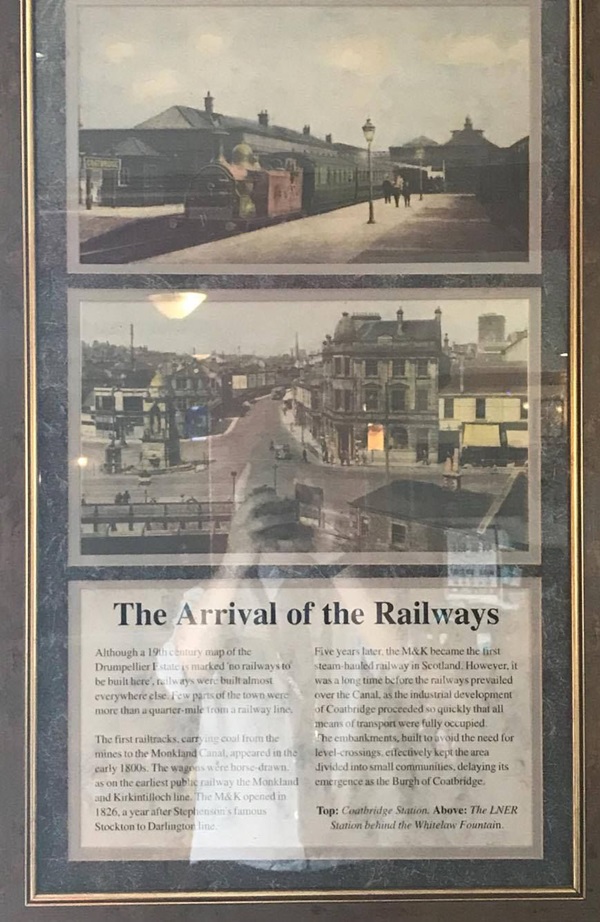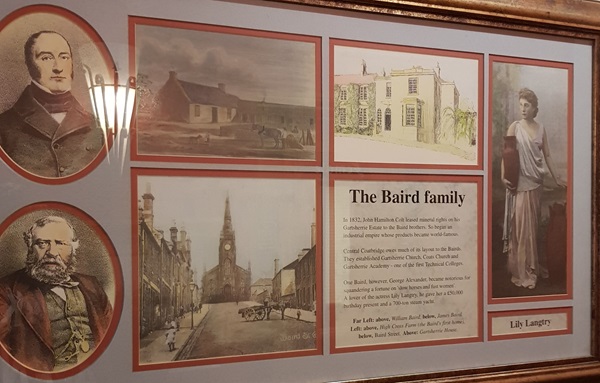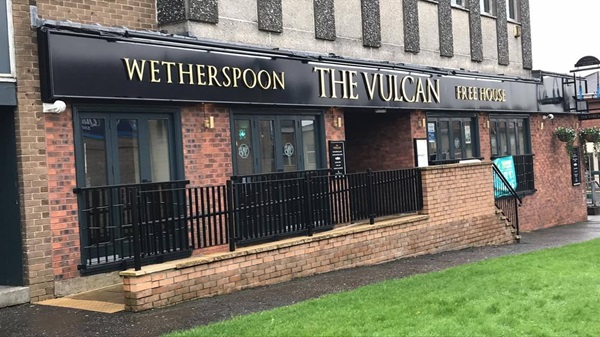This pub is closed permanently. Your nearest Wetherspoon pub: The Brandon Works
The Vulcan was the first iron boat to be built in Scotland. A full-size replica of the boat, which gave this Wetherspoon pub its name, is on show in the Summerlee Heritage Museum. Centuries later, countless vessels passed along the Monkland Canal which ran close to this pub.
Prints and text about The Vulcan.

The text reads: In 1819, the Faskine boatyard of Thomas Wilson built Scotland’s first iron-hulled boat, the Vulcan. Designed by Sir John Robinson, of the Forth & Clyde Canal Company, the Vulcan was constructed from iron plates supplied by the Calderbank Ironworks.
The boat was 61 feet long by 11 wide, and was intended to carry passengers on the Forth & Clyde Canal.
At her launch in May 1819, she was the subject of some wonder, as many people did not believe that an iron vessel would float.
The Vulcan was the first of many ships, such as the Queen Mary, to be built from iron (and later steel) plates made in Coatbridge. She served on the canal, and afterwards on the Clyde, until being scrapped in 1873.
Over a century later roles were reversed when British shipbuilders on the Clyde, built a full sized replica of the Vulcan for display in the Summerlee Heritage Museum.
Top: Vulcan being built
Centre: Replica of the Vulcan completed, 1988
Above: Model of the Vulcan.
Prints and text about the arrival of the railways.

The text reads: Although a 19th century map of the Drumpellier Estate marked ‘no railways to be built here ‘, railways were built almost everywhere else. Few parts of the town were more than a quarter mile from a railway line.
The first rail tracks, carrying coal from the mines to the Monkland Canal, appeared in the early 1800s. The wagons were horse-drawn as on the earliest public railway the Monkland and Kirkintilloch line. The M&K opened in 1826, a year after Stephenson’s famous Stockton to Darlington line.
Five years later, the M&K became the first steam-hauled railway in Scotland. However, it was a long time before the railways prevailed over the canal, as the industrial development of Coatbridge proceeded so quickly that all means of transport were fully occupied. The embankments, built to avoid the need for level crossings, effectively kept the area divided into small communities, delaying its emergence as the Burgh of Coatbridge.
Top: Coatbridge Station
Above: The LNER station behind the Whitelaw Foundation.
An illustration and text about tube-making.

The text reads: On Main Street, near this pub, next to the Phoenix and Clifton Iron Works, stood Coats Tube Works. This and several other tube making concerns were amongst the many secondary industries established in the mid 19th century as developments of the area’s iron works.
The site was originally the Caledonian Tube Co., set up in 1844 by Joseph Baker, from Birmingham. It was later absorbed into the Stewart brothers’ empire, which became Stewarts and Lloyds – Britain’s largest tube manufacturers.
The company was founded in 1860 by Andrew Stewart, who with his brother James oversaw its removal to this area five years later when their original Glasgow premises proved too small. A major factor favouring Coatbridge was that, not being a burgh, the regulations controlling industrial pollution were almost non-existent.
The Stewarts’ first iron works was established at Coatdyke. Their influence grew to the point where Coatdyke was nicknamed ‘Stewarts Land’. Their largest factory, the Imperial Works set up in 1900, produced tubes of all sizes, ranging from one-eighth of an inch up to six feet in diameter.
During the early 1930s, hundreds of workers left Coatbridge to work in Stewarts’ new steelworks at Corby in Northamptonshire.
Illustrations and text about the Baird family.

The text reads: In 1832, John Hamilton Colt leased mineral rights on his Gartsherrie Estate to the Baird brothers. So began an industrial empire whose products became world-famous.
Central Coatbridge owes much of its layout to the Bairds. They established Gartsherrie Church, Coats Church and Gartsherrie Academy – one of the first technical colleges.
One Baird, however, George Alexander, became notorious for squandering a fortune on ‘slow horses and fast women’. A lover of the actress Lily Langtry, he gave her a £50,000 birthday present and a 700-ton steam yacht.
Far Left: above, William Baird, below, James Baird Left: above, High Cross Farm (the Baird’s first home), below, Baird street Above: Gartsherrie House.
A photograph of the Phoenix and Clifton Iron Works, Coatbridge, c1905.

External photograph of the building – main entrance.

If you have information on the history of this pub, then we’d like you to share it with us. Please e-mail all information to: pubhistories@jdwetherspoon.co.uk